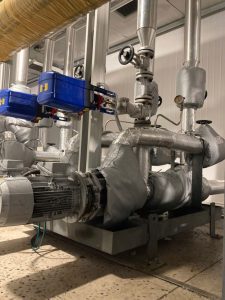In industrial environments, heat loss not only wastes energy and increases operational costs but also poses safety risks to workers. Insulation jackets (also known as insulation blankets or thermal covers) have emerged as a comprehensive and flexible solution to thoroughly address these issues.
This is an insulation system custom-designed to cover equipment such as valves, pipes, and machinery, helping to maintain stable temperatures, protect equipment, and ensure personnel safety.
What is an insulation jacket?
An insulation jacket (also known as a Removable Insulation Blanket) is a thermal insulation cover specifically designed and tailored to fit snugly around industrial machinery and equipment with complex shapes.
The biggest difference compared to permanent insulation methods is that an insulation jacket can be easily removed and reinstalled. This feature is extremely useful for routine inspections and maintenance without needing to destroy and replace the insulation system, saving significant time and cost.
The main objectives of an insulation jacket are:
- Minimize heat loss and maintain ideal operating temperatures.
- Save energy consumption.
- Ensure the safety of operating personnel from burn hazards.
- Protect equipment from environmental factors and extend its lifespan.
Detailed construction of an insulation jacket
A quality insulation jacket is typically composed of 3 specialized material layers, each playing a crucial role:
1. Outer Layer
This is the layer that comes into contact with the external environment, serving to protect the inner layers from the effects of weather, moisture, chemicals, UV radiation, and physical impacts.
- Common materials: Silicone-coated fiberglass fabric, Teflon (PTFE), or other high-performance fire-retardant and waterproof technical fabrics.
2. Core Insulation Layer
This is the “heart” of the insulation jacket, determining its thermal performance. This layer is responsible for preventing heat transfer between the equipment and the environment. The thickness and type of material are selected based on the equipment’s operating temperature.
- Common materials: Fiberglass, Ceramic Fiber, Aerogel, Mineral Wool.
3. Inner Layer
This layer is in direct contact with the equipment’s surface and must be able to withstand high operating temperatures and resist corrosion.
- Common materials: Fiberglass fabric, Silica fabric, or stainless steel mesh for extremely high-temperature applications.
In addition to the three main layers, insulation jackets also come with accessories like high-temperature straps, Velcro fasteners, and D-ring buckles to ensure a secure, tight, and neat installation.
5 Outstanding Benefits of Using Insulation Jackets
Investing in insulation jackets brings numerous economic and operational benefits to a business.
1. Save Energy, Optimize Costs
By preventing heat loss, insulation jackets help systems maintain a stable temperature with lower energy consumption. This directly reduces electricity and gas bills, contributing to the optimization of production costs.
2. Enhance Workplace Safety
The surfaces of pipes, valves, and industrial machinery are often at very high or very low temperatures, which can cause severe burns. An insulation cover creates a safety barrier, lowering the surface temperature to a safe-to-touch level and minimizing the risk of workplace accidents.
3. Protect and Extend Equipment Lifespan
Insulation jackets shield machinery from harmful environmental factors such as dust, chemicals, and moisture. Maintaining a stable operating temperature also helps reduce mechanical wear and tear, thereby extending the equipment’s lifecycle.
4. Convenient for Maintenance and Servicing
The flexible, removable design makes maintenance work quick and easy. Technicians can remove the insulation jacket to inspect the equipment and reinstall it upon completion without causing damage or incurring the cost of redoing permanent insulation.
5. Effective Noise Reduction
In addition to their thermal insulation properties, the material layers of an insulation jacket also have soundproofing effects, helping to reduce noise emitted from engines and pipes during operation, creating a quieter and safer working environment.
Common Applications of Insulation Covers
Thanks to their flexibility and high efficiency, insulation jackets are widely used in many industries:
- Power plants, oil refineries: Covering turbines, boilers, valves, expansion joints, heat exchangers, and steam pipes.
- Plastics and rubber industry: Insulating injection molding machines, extruders, molds, and drying hoppers.
- Food & beverage processing: Maintaining the temperature of boilers, tanks, and hot/cold process piping.
- Marine and shipbuilding industry: Insulating engine systems, exhaust pipes, and onboard piping.
- HVAC systems: Covering chiller lines and hot water pipes to optimize energy efficiency.
Frequently Asked Questions
What temperature can an insulation jacket withstand?
Depending on the materials, an insulation jacket can be designed to withstand temperatures from very low (-50°C) to very high (over 1000°C), meeting most industrial requirements.
Why use a removable insulation jacket instead of permanent insulation?
The biggest advantage of a removable insulation jacket is its flexibility for removal and reinstallation. This makes routine maintenance and equipment inspection extremely fast and cost-effective, as there’s no need to destroy and replace the insulation layer.
What is the average lifespan of an insulation blanket?
The lifespan of an insulation blanket depends on the working environment and the frequency of removal and reinstallation. Under ideal conditions, a quality product can last for many years.
Is it difficult to install an insulation jacket?
No. Insulation jackets are designed for easy installation and removal with integrated straps, Velcro, and buckles, and do not require highly specialized technicians.
How is the cost of an insulation jacket calculated?
The cost depends on several factors: the size and shape of the equipment, the type of insulation material, and the operating temperature. Each product is custom-made, so a specific quote will be provided for each case.










